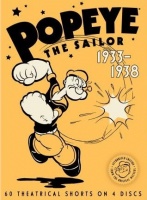 Jerry Beck is certainly no stranger to the animation community, earning his well-known reputation as an animation historian and cartoon producer. His twelve books on the subject include The Animated Movie Guide, Looney Tunes: The Ultimate Visual Guide and The 50 Greatest Cartoons. He is a former studio exec with Nickelodeon and Disney, and is currently a consulting producer to Warner Bros, Universal and Disney for their classic animation DVD compilations. Beck has programmed retrospectives for the Annecy and Ottawa Animation Festivals, The Museum of Modern Art and the Academy of Motion Picture Arts & Sciences. He has taught animation history at New York University, New York School of Visual Arts, the American Film Institute and University of California, Los Angeles. He is the host/producer of the annual Worst Cartoons Ever screening at the Comic-Con International: San Diego.
Jerry Beck is certainly no stranger to the animation community, earning his well-known reputation as an animation historian and cartoon producer. His twelve books on the subject include The Animated Movie Guide, Looney Tunes: The Ultimate Visual Guide and The 50 Greatest Cartoons. He is a former studio exec with Nickelodeon and Disney, and is currently a consulting producer to Warner Bros, Universal and Disney for their classic animation DVD compilations. Beck has programmed retrospectives for the Annecy and Ottawa Animation Festivals, The Museum of Modern Art and the Academy of Motion Picture Arts & Sciences. He has taught animation history at New York University, New York School of Visual Arts, the American Film Institute and University of California, Los Angeles. He is the host/producer of the annual Worst Cartoons Ever screening at the Comic-Con International: San Diego.
 Jerry started his career in film distribution, working at MGM/UA, Orion Classics, Cannon Films and Expanded Entertainment (Tournee of Animation), before starting his own company, Streamline Pictures in 1989, the first US distributor to import anime features such as Katsuhiro Otomo’s Akira and Hayao Miyazaki’s Laputa: Castle In The Sky. Beck was instrumental in launching Animation Magazine, and has written for The Hollywood Reporter and Variety. Beck was also the West Coast Bureau Chief for Kidscreen magazine in 2000, and has also created, written and produced animated films for various clients. His latest animation project, Hornswiggle, will air on Nickelodeon in 2007.
Jerry started his career in film distribution, working at MGM/UA, Orion Classics, Cannon Films and Expanded Entertainment (Tournee of Animation), before starting his own company, Streamline Pictures in 1989, the first US distributor to import anime features such as Katsuhiro Otomo’s Akira and Hayao Miyazaki’s Laputa: Castle In The Sky. Beck was instrumental in launching Animation Magazine, and has written for The Hollywood Reporter and Variety. Beck was also the West Coast Bureau Chief for Kidscreen magazine in 2000, and has also created, written and produced animated films for various clients. His latest animation project, Hornswiggle, will air on Nickelodeon in 2007.
Recently, Jerry spoke with Animated News & Views’ Josh Armstrong to discuss his work on The Woody Woodpecker and Friends Classic Cartoon Collection and Popeye the Sailor: 1933-1938, Volume 1, as well as some of his upcoming projects. In addition, he explained how classic animation is brought to DVD, while also sharing his thoughts on the current state of the animation industry.
Animated Views: How did you become a fan of animation?
Jerry Beck: Like with anybody else, it all goes back to your teenage or childhood years. I always liked drawing; I loved comic books. I wanted to be a comic book artist.
As I got older, I continued to draw throughout high school. People started asking, ‘What do you want to do with the rest of your life?’ I had no idea. I just knew I liked cartoons.
I started watching Bugs Bunny again in the afternoon, when I came from high school, as he made me laugh. You’ve got to remember this was back in the 1970s. Back in the ’70s, we didn’t have The Simpsons. We didn’t have the internet. So if you came home from school and Bugs Bunny was on, it was really good and really funny.
I felt, as everyone did, that cartoons were for kids. But I was watching them as a high school student and thinking, ‘These are funnier to me now! I’m really noticing the artwork! It’s so cool and well-done!’ That was really the beginning. That was really the spark, when I was like 15, 16 or 17 years old. I would just really appreciate those older cartoons.
In those days, new cartoons were crap. I talk to people who grew up in the ’70s, ’80s and ’90s, and they just love the TV cartoons they grew up with. But when I was growing up, TV cartoons – I even knew it then – were not as good as the ones that were made before.
 Anyway, that was the beginning of my love for animation. I wanted to know more about old cartoons. There were no books about them. There was no internet. It’s hard to believe, I guess, to a lot of people today. There was nothing written about Looney Tunes, Max Fleischer cartoons, or things like that. Those books didn’t start arriving until around 1975, with Joe Adamson’s Tex Avery: King Of Cartoons and Leslie Cabarga’s The Fleischer Story. I don’t think there was anything on Warner Bros. cartoons.
Anyway, that was the beginning of my love for animation. I wanted to know more about old cartoons. There were no books about them. There was no internet. It’s hard to believe, I guess, to a lot of people today. There was nothing written about Looney Tunes, Max Fleischer cartoons, or things like that. Those books didn’t start arriving until around 1975, with Joe Adamson’s Tex Avery: King Of Cartoons and Leslie Cabarga’s The Fleischer Story. I don’t think there was anything on Warner Bros. cartoons.
Before he was very famous, I got to meet Leonard Maltin. He had just done the book The Disney Films. He was teaching a class about animation history, in New York. When I got out of high school, I enrolled in that class. I just had to meet this guy and talk to him. We ended up becoming best friends, and we are very good friends today. I worked with him on the book Of Mice and Magic, which came out in 1980. That was really one of the first books to look at all the animation studios from the Golden Age of Hollywood. By working on that book, my own personal interest in classic cartoons just magnified 1,000%.
I really haven’t stopped researching cartoons since that time. You would think that doing a book like that, that’d be the end. ‘Close the book, it’s done. There it is.’ But there has been so much more information that keeps coming out. Thanks to the internet, there’s even more information coming out now – more research and observation than ever before, on these great cartoons from the Golden Age.

Jerry Beck (left) speaks with Osamu ‘Father of Anime’ Tezuka, in 1979
(Click to view high-res version)
Not only that, there are so many good things that have been happening in the last 20 years, where there’s been sort of a renaissance in Disney animation and TV animation – a real renaissance in good-looking cartoons, funny cartoons, cartoons that are not just aimed at children but aimed at all audiences, anime…I mean, there’s so much to explore. It’s a rich field. I’m just immersed in it.
AV: How were you introduced to Woody Woodpecker and Popeye the Sailor?
 JB: Like everybody else, on television. You know, Popeye was the biggest character of the 1930s – people forget that. They remember Disney, Snow White and Three Little Pigs, but Popeye was bigger than all of that. Popeye was the biggest character. He superseded Mickey Mouse, who was the biggest character from 1928-1933. But Popeye came on and really became a sensation. That’s why they made twenty years of theatrical cartoons. Then, in 1956, they put them on television. When they did that, there was a second renaissance of Popeye. Popeye was the biggest cartoon character in the late ’50s into the ’60s. People forget that.
JB: Like everybody else, on television. You know, Popeye was the biggest character of the 1930s – people forget that. They remember Disney, Snow White and Three Little Pigs, but Popeye was bigger than all of that. Popeye was the biggest character. He superseded Mickey Mouse, who was the biggest character from 1928-1933. But Popeye came on and really became a sensation. That’s why they made twenty years of theatrical cartoons. Then, in 1956, they put them on television. When they did that, there was a second renaissance of Popeye. Popeye was the biggest cartoon character in the late ’50s into the ’60s. People forget that.
That’s when I was growing up as a small child. I saw Popeye on TV, as a kid, and I loved those cartoons. Everyone who grew up in that period knows how great they are. So many things about them are great. In the intervening years, Popeye slowly disappeared. The people who controlled the characters had completely forgotten what made the character great. It was the original comic strip and original Fleischer cartoons. You may have grown up with Popeye & Son or some redone version that Hanna-Barbera may have done in later years. But that’s not Popeye. That’s not the Popeye we grew up with from the earlier days. So I just wanted to see these things come back out. It’s hard to believe they were on ice for twenty years.
Woody Woodpecker also had a show in the 1950s and ’60s. All these cartoons that were made for theaters were heavily displayed on television in the ’50s and ’60s. If you didn’t grow up with them in the ’30s, ’40s and ’50s, you saw them as a kid in the ’50s, ’60s and ’70s. They were just ubiquitous. They were all over the place.
When Cartoon Network started in 1992, they had nothing but their library, which was Turner’s library, so they ran all the Hanna-Barbera, Looney Tunes and Popeye cartoons. Those cartoons were introduced to a nice group of people who grew up in the early to mid ’90s. It’s hard to believe that’s a long time ago now, but it’s over ten years ago. All those kids who were 8, 9 and 10 are now 18, 19 and 20, in the workforce, and I think they would like to see and have on video these cartoons they saw when they were kids. It’s not just us old-timers who are into these old cartoons. It’s even people in their twenties.
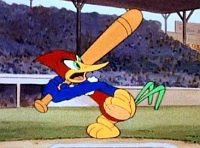 It’s the end of an era, because throughout my lifetime, these classic cartoons, such as Woody Woodpecker, Popeye and Looney Tunes, have always been on television. In only the last 5 -7 years have they stopped running these old classic cartoons on TV. Some of them are still on Boomerang, or here and there. But a lot of them have really gone off the face of the earth. So it’s kind of like the real mission now is to keep these classic cartoons alive. Otherwise, they’re going to be extinct. It’s just a matter of people who are at the right studios to make these things available.
It’s the end of an era, because throughout my lifetime, these classic cartoons, such as Woody Woodpecker, Popeye and Looney Tunes, have always been on television. In only the last 5 -7 years have they stopped running these old classic cartoons on TV. Some of them are still on Boomerang, or here and there. But a lot of them have really gone off the face of the earth. So it’s kind of like the real mission now is to keep these classic cartoons alive. Otherwise, they’re going to be extinct. It’s just a matter of people who are at the right studios to make these things available.
AV: Why do you feel some of the later cartoons for characters like Woody and Popeye left something to be desired?
JB: Well, things have certainly turned around in the last 15 years. But there was a period somewhere in the ’60s, ’70s and ’80s where animation in general was really at a downturn. That had to do with a lot of factors. It had to do with all the outlets for animation. The outlets for animation in the ’60s, ’70s and early ’80s were simply television. We had no cable, internet, DVD or VHS. The only outlet that anybody could make animation for was basically Saturday morning television.
There were some exceptions to the rule. There were some animated features here and there. There were some TV specials. There were occasionally shorts. But mainly, it was for TV. TV dictated, in previous decades, the cartoonists’-created cartoons. The artists and animators at Warner Bros. came up with Bugs Bunny and Tom & Jerry, and Disney with Mickey Mouse. The early TV cartoons were also creator-driven, as we say today, when we had things like Beany & Cecil, Alvin & the Chipmunks, Rocky & Bullwinkle and things like that. Those were kind of clever things that were done back in the early TV era.
But by the late ’60s, the animators wanted to keep working. They were all getting older. No young people were coming into the field. It was the same people who were making cartoons in their 40s, 50s and 60s. By the point, they were getting older, and they just wanted to keep their jobs. They wanted to be able to keep their homes. They just said, ‘Look, you’re the network. I’m bringing in stuff to pitch to you. You’re not happy. What do you want?’ As soon as they said, ‘What do you want,’ networks started telling them what they wanted.
 What the networks wanted was lame ideas. It’s not that they wanted lame ideas. They just didn’t have any ideas. They weren’t creators. They said, ‘Why don’t you do an animated show based on Happy Days or I Dream of Jeannie? How about a Super Robotic Three Stooges?’ It was just stupid things that didn’t make any sense! Everything was very derived. Once they would hit on an original idea – such as Scooby-Doo, possibly the last of the original ideas for TV cartoons – they would endlessly copy it, doing ten other derived versions of the same kind of show. ‘Let’s combine Scooby-Doo with the Archie’s! We’ll do the Hardy Boys or Goober & the Ghost Chasers!’ They were coming up with all these things that were just lame.
What the networks wanted was lame ideas. It’s not that they wanted lame ideas. They just didn’t have any ideas. They weren’t creators. They said, ‘Why don’t you do an animated show based on Happy Days or I Dream of Jeannie? How about a Super Robotic Three Stooges?’ It was just stupid things that didn’t make any sense! Everything was very derived. Once they would hit on an original idea – such as Scooby-Doo, possibly the last of the original ideas for TV cartoons – they would endlessly copy it, doing ten other derived versions of the same kind of show. ‘Let’s combine Scooby-Doo with the Archie’s! We’ll do the Hardy Boys or Goober & the Ghost Chasers!’ They were coming up with all these things that were just lame.
The animation quality was horrible. It all had to be done between March – or April – and September, when it had to air. So you had six months to do 13 half-hours. Your quality is going to go way, way down. That’s what happened. Things turned around with Nicktoons and Cartoon Network. Once they started original cartoons, they brought back the creator-driven sensibility. Even the worst cartoons today look great. They move really well. So we’re at a very good level of TV animation today. It’s not what it used to be.
AV: Let’s talk about your time working with the recent Woody Woodpecker and Friends Classic Cartoon Collection. Could you explain your involvement with that project?
 JB: Through the grapevine, someone told me last year that they had heard Universal was thinking of doing something with Woody Woodpecker for 2007. When I heard that, I didn’t know if there was any truth to it, but I decided to, just out of the blue, contact the president of Universal Home Video. I just wrote the guy an e-mail, told him who I was and what I had done with Warner Bros, and that if they were going to do something with Woody Woodpecker, I would be happy to take a look at what they were doing and give them some advice from the collector’s point of view. They took me up on it and ended up hiring me as a consultant.
JB: Through the grapevine, someone told me last year that they had heard Universal was thinking of doing something with Woody Woodpecker for 2007. When I heard that, I didn’t know if there was any truth to it, but I decided to, just out of the blue, contact the president of Universal Home Video. I just wrote the guy an e-mail, told him who I was and what I had done with Warner Bros, and that if they were going to do something with Woody Woodpecker, I would be happy to take a look at what they were doing and give them some advice from the collector’s point of view. They took me up on it and ended up hiring me as a consultant.
Universal had a certain point of view on how they were going to do the set. I came in and basically said, ‘This is what I would do.’ To their credit, they decided to try it out and go with what I had suggested. I’m very happy about that. I’m a happy boy, because I was able to inform them of a few things they didn’t know they owned – things that ended up as bonus features on the set. I wanted to see the Oswald Rabbit, Swing Symphony and Tex Avery cartoons…I wanted to make sure that certain things were there.
I wanted it to be a killer set, containing the best Woody Woodpecker cartoons, in basically chronological order, from the ’40s up. It’s like, if they were only going to put out one set of Woody Woodpecker, and if it came out and bombed, at least this set with all of these great cartoons would have been out there. Yes, there are more great cartoons that can come out, if they do a Volume 2. We don’t know if they will yet. But I always looked at this as the one shot for releasing Universal’s cartoons. So I took advantage of that. I wanted it to be the best it could possibly be, so that would fans would be happy, and even if you weren’t a fan, you might become a fan by looking at this set. I wanted it to get good reviews and hopefully sell well, so that Universal would release more Woody Woodpecker volumes. I feel very proud of that; I feel like we accomplished a goal there.
AV: You also worked on Popeye the Sailor: 1933-1938, Volume 1. How did you become involved with that DVD set?
JB: When I was in New York City, where I grew up, one of my very first jobs was working for United Artists, in the late ’70s. I was so happy to be working in the movie business, because I was 3,000 miles from the real movie business. But it was wonderful to have a main office in New York, at United Artists.
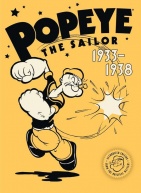 United Artists had the rights at the time to the old Popeye and Looney Tunes cartoons. That was, of course, great for me. I worked in an department that dealt with those cartoons. So I was really in hog heaven, at the time. From that time forward, home video finally came in, around ’78, ’79 or ’80. I was involved then with helping to advise. Because of my knowledge of the cartoons, I would help United Artists in putting out cartoons on video.
United Artists had the rights at the time to the old Popeye and Looney Tunes cartoons. That was, of course, great for me. I worked in an department that dealt with those cartoons. So I was really in hog heaven, at the time. From that time forward, home video finally came in, around ’78, ’79 or ’80. I was involved then with helping to advise. Because of my knowledge of the cartoons, I would help United Artists in putting out cartoons on video.
There was a problem with the Popeye cartoons at the time. It was a legal problem between King Features Syndicate and United Artists. It was a legal dispute over whether they had the rights to put them out on video. United Artists had the rights for television. They had the rights for all sorts of things for the old Popeye cartoons. But there was a big dispute about whether they could put the cartoons on home video.
The Popeye cartoons were never, ever, ever officially put out on home video. There have been bootleg DVDs and public domain Popeye cartoons, where the copyright had lapsed, throughout the years. There have been tapes. Those have been out in really funky form for a while. But there has never been an official release from the original materials – negatives and things like that – of these Popeye cartoons. They haven’t been restored. In fact, they were ruined by Ted Turner, who acquired the library from United Artists. He bought United Artists, acquired the library and colorized the Popeye cartoons sometime around 1980, I think – maybe it was a little later than that, such as around ’84. What happened then in history is that Turner ultimately started Cartoon Network and put Popeye cartoons on there. But it was later merged with Warner Bros. Warner Bros. acquired his library, which included the early Looney Tunes cartoons. They already had, of course, their later Looney Tunes cartoons from the ’50s and ’60s. But now Warner Bros. has all of its Looney Tunes cartoons back after a bunch of years. Then, they also got the Popeye cartoons, but they couldn’t put them out on video. So it took years for Warner Bros. to make a deal.
My involvement stems from the fact that I have always stayed in touch with the people who put out these cartoons. My reputation grew throughout the years as someone they could talk to about what cartoons should go on these discs and things like that. I had been working with the Turner people and then the Warner Bros. people on the Looney Tunes series and some other DVDs. Then, when Warner Bros. was getting very, very close with King Features to finalize that deal to make Popeye available, I was already there. I was already involved, working on the Looney Tunes Golden Collection.
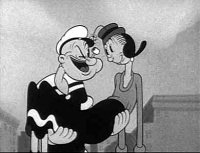 I’ve been working on those DVD sets as a consultant. I don’t work for the company full-time. But I do work as a paid consultant on the animation material. So that’s kind of how I got involved. They asked me early on, ‘If we were to do Popeye, how would you see doing it?’ Really easily, I just said, ‘Oh, in this case, you’ve got to go chronological. Put the first 60 on.’ I looked at how many cartoons there were; I knew how many cartoons you could fit on four discs. So we decided on 60 for the first set. The second set, which will be out next year, will be the rest of the black-and-white cartoons from ’38 to around ’42. Then, the third set will be mainly the color cartoons of the ’40s. Then, the fourth set will be the color cartoons of the ’50s. There will be surprises, really great extras and all kinds of nifty things on each subsequent volume.
I’ve been working on those DVD sets as a consultant. I don’t work for the company full-time. But I do work as a paid consultant on the animation material. So that’s kind of how I got involved. They asked me early on, ‘If we were to do Popeye, how would you see doing it?’ Really easily, I just said, ‘Oh, in this case, you’ve got to go chronological. Put the first 60 on.’ I looked at how many cartoons there were; I knew how many cartoons you could fit on four discs. So we decided on 60 for the first set. The second set, which will be out next year, will be the rest of the black-and-white cartoons from ’38 to around ’42. Then, the third set will be mainly the color cartoons of the ’40s. Then, the fourth set will be the color cartoons of the ’50s. There will be surprises, really great extras and all kinds of nifty things on each subsequent volume.
So basically I was the general, overall watchdog and consultant on this Popeye DVD set, making sure some factual things were done correctly. I only had so much control, but I did what I could to get it to the level that it is. The people at Warner Bros. are great, but if there weren’t somebody around like me who knows the collection, you might end up with colorized cartoons or an unrestored print. I was sort of there to make sure everything was done the way we collectors would want it.
AV: It sounds as if the sets might have been pretty different if you hadn’t been involved with them. Could you describe some of the changes you helped make?
JB: In the case of Woody, they were going to do something along the lines of the Pink Panther box set that came out. Remember that set that had all the Pink Panther cartoons? They were going to do something where they were just going to include all the Woody Woodpecker cartoons. Obviously, for a collector, that’s an interesting thing. I wouldn’t mind having that.
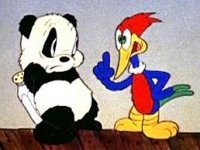 So I went and spoke to the man and had a nice meeting with him. I asked, ‘Well, what about Andy Panda? What about Chilly Willy? What about these other characters?’ They had done their marketing research, and the research said that nobody knew who those characters were. Therefore, they weren’t going to put out anything without just Woody Woodpecker. ‘People know who Woody Woodpecker is, so Woody Woodpecker is all we’re going to do.’
So I went and spoke to the man and had a nice meeting with him. I asked, ‘Well, what about Andy Panda? What about Chilly Willy? What about these other characters?’ They had done their marketing research, and the research said that nobody knew who those characters were. Therefore, they weren’t going to put out anything without just Woody Woodpecker. ‘People know who Woody Woodpecker is, so Woody Woodpecker is all we’re going to do.’
Basically, my job, which I succeeded at, was to convince them not to put all the Woody Woodpecker cartoons out in one shot. After all, let’s say you did that, and it was successful, you would have nothing else to put out in Volume 2. So at least if you put a third of them, which is what we did, and it’s successful, then you have a chance for a set #2 and a set #3.
At the same time, the collectors are getting these other cartoons, such as Chilly Willy and Andy Panda, which is the equivalent in the studios’ language to bonus material. If I hadn’t been involved, there might have been a ‘Complete Woody Woodpecker’ set out. For anybody that’s crying about the fact that they’re not getting the 1962 Woody Woodpecker cartoons, don’t worry, they’ll be coming soon. I think we got a better deal here.
In the case of Popeye, I’m not sure exactly how different that would have been. They might have done something where they mixed it up. For instance, they might have done themes. They might have done something where Disc 1 was ‘Popeye’s Travels’ and Disc 2 was ‘Popeye’s Tasks.’ They would have done some kind of thematic thing, perhaps. They also might have used the colorized cartoons or maybe more than a few of them by accident. They would have maybe used some of the original prints off the shelf that were faded in color.
That’s how I think my standing in the doorway kept things on track for what the collectors wanted. I was very insistent about the Paramount ones being restored, even though the set was being released by Warner Bros. and King Features. They had nothing to do with Paramount Pictures. The studio had to go get Paramount Pictures’ permission to put the Paramount mountain back on the cartoons, which is the way the films were originally made. They were made for Paramount.
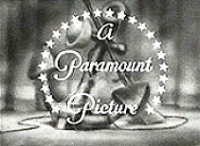 As it turned out, Warner Bros. was able to make a deal with Paramount Pictures. Coincidentally, Paramount had recently acquired the rights to a few John Wayne movies that were first owned by Warner Bros. Apparently, Paramount wanted to release those John Wayne films as they were originally released, with the Warner Bros. shield.
As it turned out, Warner Bros. was able to make a deal with Paramount Pictures. Coincidentally, Paramount had recently acquired the rights to a few John Wayne movies that were first owned by Warner Bros. Apparently, Paramount wanted to release those John Wayne films as they were originally released, with the Warner Bros. shield.
Therefore, the two companies reached an agreement. Paramount was granted permission to use the Warner Bros. shield on the John Wayne films, while Warner Bros. could use the Paramount Pictures mountain on the Popeye shorts. It was a fluky coincidence that actually worked out to the companies’ advantage, in that no money had to be exchanged. With that said, to see these Popeye cartoons the way they were originally released is just a real treat.
AV: Why do you feel Warner Bros. and Universal wanted to release the Popeye and Woody sets so close together in August?
JB: I know that Warner Bros. has a regular release schedule throughout the year. They mainly release their big cartoon sets at Christmastime. They still have a bunch of really great DVDs that will be coming out around November.
I think, in the case of Popeye, the deal was made about a year ago. Once they’ve decided to release a DVD set, it takes about a year for it to come out. I also think that it’s good they released it separately from the Christmas pack, because it gave it its own attention. More attention to be paid to Popeye than if it were lost in the shuffle with another Looney Tunes set and a new Scooby-Doo movie. It would have just been lost with a group of new releases. It wouldn’t have stood out like I think it did when it was released.
![]() Now, coincidentally, Universal decided to release Woody Woodpecker right at the same time. I don’t think the release date for the set had anything to do with the San Diego Comic-Con being that same week. It was a coincidence. Actually, if I had to have picked a release date other than one at the end of the year, it would have been during the Comic-Con. I know that, obviously, Warner Bros. took advantage of the Comic-Con. They had a panel set up, which I was on to promote the Popeye DVD. That was a good promotion.
Now, coincidentally, Universal decided to release Woody Woodpecker right at the same time. I don’t think the release date for the set had anything to do with the San Diego Comic-Con being that same week. It was a coincidence. Actually, if I had to have picked a release date other than one at the end of the year, it would have been during the Comic-Con. I know that, obviously, Warner Bros. took advantage of the Comic-Con. They had a panel set up, which I was on to promote the Popeye DVD. That was a good promotion.
The Woody Woodpecker DVD set didn’t get that sort of promotion at all. Comic-Con had absolutely nothing to do with Universal deciding to release the set at that time. I think, in the case of Woody, they just wanted to do it as a summer set. They had in mind all along from a year ago that they wanted it to come out this past summer. It could have had something to do with people vacationing at Universal theme parks. It could have been any number of reasons as to why they figured the summer was an advantageous time to release a great collection of classic animation.
I actually think it’s kind of great that the sets both came out within a week of each other, because, in theory, we got some articles that would promote both sets, as opposed to a guy saying, ‘Well, I don’t know if I should write about this Woody Woodpecker set…’ But the fact that Woody and Popeye came out at the same time, it gives two reasons to promote an article about classic cartoons. I don’t think the studios themselves would go out and pitch to a reporter. But I think it’s helpful; I think both can help each other. I know a lot of the people buying Woody are buying Popeye, and vice versa. I think it can only help.
AV: What was your main goal for the Woody Woodpecker and Popeye DVD collections?
JB: My goal for any of the DVD sets that we work on is, first, to make the cartoons accessible. These cartoons are inaccessible. They’re not on the Cartoon Network right now. They’re not on video anywhere. They’re not allowed to be on YouTube or the internet. They haven’t been officially put out. They’re just locked away in the vaults. So my first goal is to have the cartoons accessible.
 Number two is to have them accessible in the original form that they were released. Throughout the years, these cartoons have been chopped to bits for editing due to content pertaining to violence, racism, sexist attitudes, smoking, or this or that. There are so many reasons these cartoons have been cut or are not shown anymore, because they reflect America back in the 1930s, ’40s and ’50s. They don’t reflect the way America is today. They’re not exactly child-friendly. They’re not exactly perfect kids’ fodder, as people rule on stuff to be.
Number two is to have them accessible in the original form that they were released. Throughout the years, these cartoons have been chopped to bits for editing due to content pertaining to violence, racism, sexist attitudes, smoking, or this or that. There are so many reasons these cartoons have been cut or are not shown anymore, because they reflect America back in the 1930s, ’40s and ’50s. They don’t reflect the way America is today. They’re not exactly child-friendly. They’re not exactly perfect kids’ fodder, as people rule on stuff to be.
Meanwhile, the studios are doing their own new cartoons today, such as The Powerpuff Girls or Spongebob Squarepants. So they don’t really need these old cartoons. The cartoons are locked away. The problem is that the studios forget that these cartoons are classic films. They’re not just old kids’ shows. They’re classic movies. That’s something I like to remind people about, on these sets.
So my goal was to make the cartoons accessible in their original form with their original studio logos and uncut in any other way, restored so they look brand-new. Some of the cartoons look brand-new, like they were made yesterday. There’s no excuse for cartoons looking old. Cartoons don’t date the way live-action films do. If you restore them right, they’ll look like they were made yesterday.
I want the collections to look as though they were done with some class. I like, for example, the Popeye box. This is the one place where I have no control, unfortunately. I have no control over the artwork or the menus on the Looney Tunes, Tom & Jerry, Woody Woodpecker and Popeye DVD sets. Really, that has to do with marketing. They have a whole other department that deals with marketing. I’m involved more with the content of the discs.
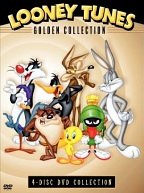 I always try my best to help influence the DVD packaging. The closest I’ve come was with the Popeye set. I can’t really take any credit for it, but I did have a meeting once where they asked me what kind of packaging I thought we should go for. My whole thing was to make sure it didn’t look like the public domain videos that are out there. It had to stand apart from the other animation collections. It had to have some class. It had to be adult. ‘Don’t make it look like a kiddie show. Make it look like this is a classic character and these are classic cartoons.’ There are ten other ways the Popeye packaging could have gone. But what was released is pretty good looking. I really like it. It respects the content inside.
I always try my best to help influence the DVD packaging. The closest I’ve come was with the Popeye set. I can’t really take any credit for it, but I did have a meeting once where they asked me what kind of packaging I thought we should go for. My whole thing was to make sure it didn’t look like the public domain videos that are out there. It had to stand apart from the other animation collections. It had to have some class. It had to be adult. ‘Don’t make it look like a kiddie show. Make it look like this is a classic character and these are classic cartoons.’ There are ten other ways the Popeye packaging could have gone. But what was released is pretty good looking. I really like it. It respects the content inside.
Unfortunately, I cannot say that every animated DVD collection respects its content. Sometimes, a set is marketed more toward moms and kids. I do not know if it is correct to aim some of the sets at those targets, though. With a lot of these older cartoons, moms and kids do not even know who the characters are anymore. Therefore, when it comes to marketing DVD collections for classic animated titles, I respectfully advise the studios, ‘Go for the collectors, a group far larger than just some guy in a basement.’
Yes, there is a huge audience for classic cartoons. But the shows have to be marketed the right way. If they are marketed simply toward children, part of the potential audience is cut off.
I really have to convince a lot of people to check out certain animated DVD collections. Unfortunately, I know some people who are simply turned off by the set’s box artwork. I have spoken with people who said, ‘Boy, the box art doesn’t look encouraging to me.’ My response is, ‘Well, don’t judge the set by its box art! It’s what is inside the box that is fantastic!’
AV: Is there anything else you wish studios in general had done differently about some of the classic animation sets that have been released?
JB: Well, let’s see. I can’t complain too much about content. I mean, there are glitches and problems, minor things here and there. There are some little mistakes that happen when they’re putting these things together that I wish weren’t there. I wish I could go back and remaster the whole darn thing. With Tom & Jerry, they put in some edited cartoons by mistake, and then they had to go back and do replacement discs for people who complained. They wouldn’t have to do that in the first place, if they had somebody like me who was doing quality control upfront. First thing, I’m not hired to do that. They don’t allow me to come in to advise on that regard. I see a lot of this stuff when it’s too late, maybe two weeks before it’s going to come out.
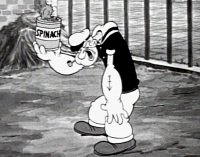 But I love the bonus materials. I love the fact that the cartoons are out there. You know, when fans on the internet complain about this or that, I call it ‘nitpicking.’ That’s okay, I’m glad they’re catching these boo-boos, these little things that are wrong. But they’re looking at the glass as half-empty instead of half-full. I live in a world where these DVDs once didn’t exist.
But I love the bonus materials. I love the fact that the cartoons are out there. You know, when fans on the internet complain about this or that, I call it ‘nitpicking.’ That’s okay, I’m glad they’re catching these boo-boos, these little things that are wrong. But they’re looking at the glass as half-empty instead of half-full. I live in a world where these DVDs once didn’t exist.
There is still a lot of stuff that still isn’t out there. We’re living in a world now where Song of the South isn’t out yet. I want Song of the South to come out. Hopefully, it will be a great transfer, and there will be nothing to complain about. But you know what, there will be people on the internet who will find some boo-boo, or somebody who’s going to go, ‘You know, the Japanese laserdisc ten years ago was a lot better.’ You know what, they can complain all they want. I am just delighted to sit here and be able to put these cartoons that I love on any time I want, in great-looking copies, with the studios’ complete cooperation. I can’t really complain about some of the little things that aren’t really worth complaining about. I’m looking at it as that we’re living in a wonderful time where the studios are actually releasing this stuff.
My biggest problem with studios are the ones who don’t release stuff. Viacom and Paramount own Terrytoons: Mighty Mouse, Heckle & Jeckle, Mighty Heroes, Dippity Dog – I could go on and on. They own the rights to Betty Boop and Lil’ Audrey. I mean, they have all these things that haven’t come out yet. It’s almost an endless list. The classic Mr. Magoo cartoons from the theaters, not the TV ones. Where are all the good UPA cartoons that were made in the 1950s? There are so many wonderful things in the libraries of these Hollywood studios that they’re just sitting on, because they feel there is no audience for this material. They feel there would be no sales. It’s not worth $25,000 per cartoon to restore each cartoon and release a set of 60 or 90 cartoons. That’s cost prohibitive. They’re not going to make their money back. That’s their point of view. So there are a lot of issues.
 I try to look for opportunities. For instance, I believe that there are going to be new Mr. Magoo cartoons for Nickelodeon – I’ve heard that, but I don’t know if it’s true or not. When I hear something like that, I like to go over to the people at Columbia Pictures and say, ‘You know, this series is coming out. It’s going to be on Nickelodeon. You really should be thinking about doing a box set for the classic Mr. Magoo cartoons.’ I try to get them interested in doing it, when we know an old classic cartoon character is going to be in a new movie or series. I try to find a way to tie-in their library to that new movie. ‘Oh yeah, there’s going to be a Mighty Mouse movie! We should put out the old Mighty Mouse cartoons!’ Once the studios even begin to agree to that, I then explain, ‘Okay, well, here’s what you should do. You should put out the Mighty Mouse set, Mighty Mouse & Friends, and let’s put Heckle & Jeckle on there.’ Because if you don’t say it, the studios are never going to do it. They’re never going to put out that other stuff, because they don’t perceive the value of those other characters.
I try to look for opportunities. For instance, I believe that there are going to be new Mr. Magoo cartoons for Nickelodeon – I’ve heard that, but I don’t know if it’s true or not. When I hear something like that, I like to go over to the people at Columbia Pictures and say, ‘You know, this series is coming out. It’s going to be on Nickelodeon. You really should be thinking about doing a box set for the classic Mr. Magoo cartoons.’ I try to get them interested in doing it, when we know an old classic cartoon character is going to be in a new movie or series. I try to find a way to tie-in their library to that new movie. ‘Oh yeah, there’s going to be a Mighty Mouse movie! We should put out the old Mighty Mouse cartoons!’ Once the studios even begin to agree to that, I then explain, ‘Okay, well, here’s what you should do. You should put out the Mighty Mouse set, Mighty Mouse & Friends, and let’s put Heckle & Jeckle on there.’ Because if you don’t say it, the studios are never going to do it. They’re never going to put out that other stuff, because they don’t perceive the value of those other characters.
I only care about having the stuff accessible and out there. I have no financial gain from it. The company has all to gain, in licensing, selling the DVDs, etc. They have all to gain in promoting those classic, iconic characters that they own the rights to. I’m just a fan. I’m just sitting at home, wanting to be able to turn my TV on and watch some of these old cartoons again. That’s my goal – just to help make these cartoons accessible.
AV: Why do you think studios still use DVNR (Digital Video Noise Reduction) on classic cartoons, even though fans and influential people such as yourself want otherwise?
JB: Well, they use it because they don’t understand. I would have said, ‘They don’t care,’ but that’s not true. They don’t want to put out a product that’s faulty. Like anybody else, I’m a lazy person, believe it or not. It’s like you want to do the easiest thing that you can do. Someone came up with a system to clean up live-action films. This process is an electronic one that takes out dust and dirt from frames. So you run a film through it, and you can claim it’s ‘Digitally Clean! Digitally Remastered!’
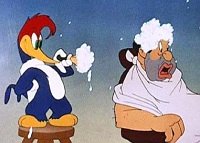 The problem with DVNR is that it doesn’t work with animation. You know, when you’re in these big companies, and you’re doing x-number of movies per year, and you’ve got a couple of animation releases, it seems that it doesn’t pay not to do it. ‘Run them all through the cleanup system, because we know it’s really great! It will remove that speck in that one frame!’ Unfortunately, it removes lines from animation, because it thinks that a line on a character that is only there for one frame is dirt, so it removes the line. So some of the studios just kind of don’t get it. They just don’t understand.
The problem with DVNR is that it doesn’t work with animation. You know, when you’re in these big companies, and you’re doing x-number of movies per year, and you’ve got a couple of animation releases, it seems that it doesn’t pay not to do it. ‘Run them all through the cleanup system, because we know it’s really great! It will remove that speck in that one frame!’ Unfortunately, it removes lines from animation, because it thinks that a line on a character that is only there for one frame is dirt, so it removes the line. So some of the studios just kind of don’t get it. They just don’t understand.
It’s actually extra trouble at this point not to do DVNR, because the studios are set up to use it. To not do it, it’s special – it’s like ‘Burger King: Have it your way.’ If you don’t ‘have it your way,’ if you go to McDonald’s and say, ‘Give me the hamburger,’ it comes a certain way with all the stuff on it. To suddenly ‘Burger King’ it, walk in and say, ‘I’ll take it without the DVNR,’ that’s extra trouble. That’s extra work, to remove it from the system.
It’s like constructing a paper airplane. You can take all the time in the world to fold that paper, but when you throw it out there, you have no control over where it’s going to land. It could land two or ten feet in front of you, or into the water, or whatever. That’s kind of like how I feel about doing these video releases. We fold that paper as carefully as we can, but then we have to let it go. By the time it lands into the consumer’s hands, it might not be what I had hoped, but at least I had guided in the right direction. I at least folded the paper in a way that the fans would appreciate. If it didn’t land where the fans wanted, we keep trying.
With multiple releases – I don’t know if anybody has really noticed – every single time out, we learn from the mistakes of the previous set. We try to fix it, before it happens. There are stories behind every single boo-boo and non-boo-boo. Everything that is good and everything that is bad on every one of these DVDs that I’ve been involved with, there’s a story behind.
 Companies like Classic Media – I don’t see anybody who knows what the product is having anything to do with the final material. They’re just creating a commercial product. They’re creating something they can sell in the knick-knack store, the souvenir store, where you can get all kinds of fun Betty Boop pens, pop culture books… ‘Oh, there’s a Dick Tracy cartoon set! How cool!’ But they don’t put that extra care into it that somebody who is actually interested in that product would want. I think we tried to do that.
Companies like Classic Media – I don’t see anybody who knows what the product is having anything to do with the final material. They’re just creating a commercial product. They’re creating something they can sell in the knick-knack store, the souvenir store, where you can get all kinds of fun Betty Boop pens, pop culture books… ‘Oh, there’s a Dick Tracy cartoon set! How cool!’ But they don’t put that extra care into it that somebody who is actually interested in that product would want. I think we tried to do that.
A lot of fans are finding all kinds of little things to nitpick right now on our Popeye set. But the Popeye set is probably the closest to what we were aiming that we’ve ever come. I think there are some sets, like On the Front Lines, the Disney Treasures set about World War II cartoons, that are probably almost perfect of the classic cartoon sets. I had nothing to do with that one. That was done by a few people I know. That was really, really hand-cared. From day one to the final delivery, it shows.
But the thing is, I try to guide them. I try to inform them. I try to educate them about how we can make this better. I’ll get assurances. I’ll hear, ‘Wow! Thanks for telling us that! We’ll make sure that doesn’t happen!’ Then, guess what, it comes out and still happened, because it didn’t get to the 29th guy who’s supposed to know this, in the remastering place. There’s really nobody around who’s actually looking at all these things with the right eye. It’s the kingdom of the blind. I’m sometimes the one-eyed man in the room who is able to say, ‘Okay, problem here… We should have this on the set, or we should have that on the set.’
AV: What are your thoughts on the state of animation today?
JB: I actually think it’s in good shape, all things considered. But I think it’s because when I grew up, it was in its worst shape ever, which was during the ’70s and ’80s. Ever since the late ’80s, with all the films you can think of, whether it’s The Little Mermaid, The Simpsons, Mighty Mouse or Ren & Stimpy, we’ve slowly crawled back. Even the worst shows on Cartoon Network really look great. The worst shows today are miles ahead of the kind of junk that used to piddle out in ’50s, ’60s, ’70s and ’80s. I think we’re actually in good shape here, and I think we’re even going to get better.
 I think in Pixar, we have a true creative leader in animation right now that I don’t know if we’ve had for a long time. Disney was sort of it in the ’90s. But I think Pixar is the real deal – I mean a real creative leader in the classic mold of Walt Disney, Max Fleischer, Chuck Jones, Tex Avery… Pixar is truly innovating and leading, and people are following them. I think they are making really great films.
I think in Pixar, we have a true creative leader in animation right now that I don’t know if we’ve had for a long time. Disney was sort of it in the ’90s. But I think Pixar is the real deal – I mean a real creative leader in the classic mold of Walt Disney, Max Fleischer, Chuck Jones, Tex Avery… Pixar is truly innovating and leading, and people are following them. I think they are making really great films.
We have a lot of stuff going on in cable television, whether it’s adult animation on Fox or Comedy Central. I think we’re making end-roads there. I think anime has been accepted. Again, I’ve lived through a lifetime where anime was ignored.
Despite all the cable animation, direct-to-video animation and internet animation, the one big hurdle is still the perception that animation is a children’s medium, by the large majority of people in the United States – not around the world, but the United States. We still have that hurdle to go across. I think we’re making end-roads there. But the fact that people perceive animation as a children’s medium is why people use DVNR. It’s why bad animation is produced. Because people who are saying ‘yes’ to these things don’t care. They’re just trying to make a buck. They’re just trying to create a product. ‘Oh, it’s a kid show. Who cares?’
It’s why you don’t see classic cartoons like Mighty Mouse, Baby Huey or Heckle & Jeckle on video. You don’t see these classic cartoons on DVD or anywhere, because the attitude by the people who have the rights to them is, ‘These are old kids’ fodder. We have no place to put these shows. They’re dead as a doornail. They’re like old sitcoms from the ’50s – you know, like I Married Joan or My Little Margie. They’re black-and-white, nobody knows who the people are in them, and they’re out-of-date. They have no value to distribute anymore.’ That’s how some studios consider old theatrical cartoons. And the same goes for old TV shows. More and more, I’m hearing from people grew up in the ’70s and ’80s, who are asking me about various shows that they grew up with – little shows that were only on for a year. ‘What happened to that show? I loved it when I was a kid!’ There’s no perceived market, because even though it’s a kids show, it’s perceived as an old show and one that has no value.
You know, like Warner Bros. – and this is nothing against Warner Bros. – the old, classic Warner Bros. cartoons, the MGM cartoons, etc. are divvied. They divvy up the library for people to work on at MGM, United Artists and Warner Home Video. Because their cartoons are considered children’s products, the cartoons go to the family group.
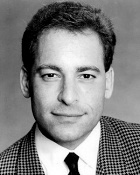 Popeye and Looney Tunes have been specially taken care of thanks to George Feltenstein, who is the president or vice president of what they call the ‘catalog’, which includes the old movies such as Gone with the Wind and Casablanca. Feltenstein is a cartoon fan. He cares. Actually, that’s one of the reasons why, on the Warner releases of old movies, you’ll always find one cartoon as a bonus feature. He’s a guy who loves cartoons. He happens to be in that position.
Popeye and Looney Tunes have been specially taken care of thanks to George Feltenstein, who is the president or vice president of what they call the ‘catalog’, which includes the old movies such as Gone with the Wind and Casablanca. Feltenstein is a cartoon fan. He cares. Actually, that’s one of the reasons why, on the Warner releases of old movies, you’ll always find one cartoon as a bonus feature. He’s a guy who loves cartoons. He happens to be in that position.
People have asked me for years, ‘Why is it that on the same day a Looney Tunes Golden Collection set comes out, something called the Looney Tunes Spotlight Collection, which doesn’t have any of the bonus material and only two discs, also comes out? What’s the point of that?’ Well, that’s thanks to the family group, which actually controls these things. They say, ‘Okay, we’ll let you put out a special set aimed at adult collectors, the Golden Collection. We’ll put out what we would do with it, the Spotlight Collection, aimed at moms and kids shopping at Wal-Mart.’
The thing is, we have proven with sales numbers that the Golden Collection is what people want and that there is an adult audience for these animations. It’s something that companies haven’t learned. They don’t want to spend any extra marketing dollars going after that crowd. They only know that cartoons sell to moms and kids at stores. So that’s why they focus everything in that direction. You know, it’s the ‘mom test.’ They’ll actually go out and survey people in malls. ‘Have you ever heard of The Get-Along Gang?’ ‘Have you ever heard of Herman & Catnip?’ A lot of people have forgotten about Herman & Catnip. So when those people answer ‘No,’ then the studios go, ‘Well, we’re not putting this out.’ If there’s high awareness of the cartoon, they will put it out.
AV: What can you tell us about your upcoming projects?
JB: Obviously, on a daily basis, I try to blog at CartoonBrew.com. It’s what I wish I could do full-time. We’re trying to create a revolution somehow at CartoonBrew.com and CartoonBrewFilms.com. However, life, work and earning money get in the way. So until we can make Cartoon Brew into something that can pay the bills, I have to do other stuff. I get to work on a lot of other fun projects. I’m going to give you as big of a list as I can.
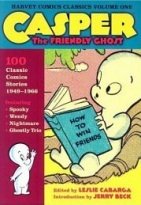 I’m doing a series of introductions to a line of books I’m very proud of, for Dark Horse Comics. These are reprints of Harvey Comics books from mainly the 1950s and ’60s. The first one, focusing on Casper the Friendly Ghost, came out in August. The next one, with Richie Rich, will arrive in October, while the following edition will deal with Hot Stuff. We’ll be doing more of the comics next year. I’m doing these with Leslie Cabarga, who’s another animation historian. He’s actually the editor, physically putting these together. The reason I’m involved with this is because I actually loved these comics from the ’50s. I won’t go too far with you on it, but one of the reasons I’m doing it is that these are animation-related. Casper and these Harvey Comics were originally, in the ’50s, drawn by the animators at Paramount Studios in New York. They look like cartoons on the page. These haven’t been reprinted since the ’60s at least. They were just lying around. Companies reprint Casper stories from the ’60s or ’70s or whatever, but here, they reprinted the ones from the ones from the ’50s, which were really cool. They look like animation on the page. I just love them. I’ve been collecting them for years. So we finagled, talking everybody into reprinting these things. I want the world to see them.
I’m doing a series of introductions to a line of books I’m very proud of, for Dark Horse Comics. These are reprints of Harvey Comics books from mainly the 1950s and ’60s. The first one, focusing on Casper the Friendly Ghost, came out in August. The next one, with Richie Rich, will arrive in October, while the following edition will deal with Hot Stuff. We’ll be doing more of the comics next year. I’m doing these with Leslie Cabarga, who’s another animation historian. He’s actually the editor, physically putting these together. The reason I’m involved with this is because I actually loved these comics from the ’50s. I won’t go too far with you on it, but one of the reasons I’m doing it is that these are animation-related. Casper and these Harvey Comics were originally, in the ’50s, drawn by the animators at Paramount Studios in New York. They look like cartoons on the page. These haven’t been reprinted since the ’60s at least. They were just lying around. Companies reprint Casper stories from the ’60s or ’70s or whatever, but here, they reprinted the ones from the ones from the ’50s, which were really cool. They look like animation on the page. I just love them. I’ve been collecting them for years. So we finagled, talking everybody into reprinting these things. I want the world to see them.
I have three other books coming out. They are mainly picture books. But I’m happy with the way they look. They’re really fun books. The thing about me is I tell people I write books that are fun. I occasionally do heavy, scholarly things, like The Animated Movie Guide. But I like to do books that are going to be fun to look at, because I love animation.
I’ve got a book on Hanna-Barbera coming out, called Hanna-Barbera Treasury. It’s a very cool book. It’s illustrated mainly with either production art or cool, funky merchandising art from the ’50s and ’60s. It doesn’t cover Hanna-Barbera past 1969. It’s just mainly the television work of Hanna-Barbera from around ’57-’69. It doesn’t really cover anything in-depth. It’s like a scrapbook of fun Hanna-Barbera stuff.
I also did a book called Nicktoons. It’s basically a super-illustrated, giant coffee table book that celebrates – well, I don’t think it’s an anniversary. I was going to say the first 15 years of Nicktoons, but I don’t even think it is 15 years. It’s more like an awkward 16 years. I think Nicktoons started in ’91. We’re in 2007. So it’s some oddball number such as 16. The book covers everything from Ren & Stimpy and Doug all the way up to shows that are coming on in the fall, like Mighty B and Barnyard. It has little interviews with creators and a lot of production art. It’s a very cool, strange book.
The third book is one of those Art of books: The Art of Bee Movie. That’s the Jerry Seinfeld/DreamWorks feature that will be coming out in November. This is one of those books that celebrates the pre-production art that goes into making one of these films. It’s the same publisher and format as the Pixar books, like The Art of The Incredibles and The Art of Finding Nemo. It’s just as good as all those books, so I highly recommend it.
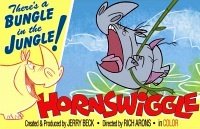 There’s also my television pilot, Hornswiggle, which I have neglected for the last six months. I did this pilot last year with Nickelodeon and Frederator. It’s going to air, but I don’t know exactly when. I personally think it will air either in the fall or early spring of next year, as part of a new show on Nickelodeon called Random Cartoons. In fact, Random Cartoons is actually in my Nicktoons book. It gets a few pages. Random Cartoons is a show for Nick, but it isn’t on the air yet. It’s completely finished, though. It’s 13 episodes of 39 pilots really, but it’s being marketed as 39 different ‘random cartoons.’ The thing about Hornswiggle is that the rights revert back to me, if they don’t pick it up in the series. So when my rights revert back to me, in October, I’m planning to pitch Hornswiggle around and sell it as a series to somebody else.
There’s also my television pilot, Hornswiggle, which I have neglected for the last six months. I did this pilot last year with Nickelodeon and Frederator. It’s going to air, but I don’t know exactly when. I personally think it will air either in the fall or early spring of next year, as part of a new show on Nickelodeon called Random Cartoons. In fact, Random Cartoons is actually in my Nicktoons book. It gets a few pages. Random Cartoons is a show for Nick, but it isn’t on the air yet. It’s completely finished, though. It’s 13 episodes of 39 pilots really, but it’s being marketed as 39 different ‘random cartoons.’ The thing about Hornswiggle is that the rights revert back to me, if they don’t pick it up in the series. So when my rights revert back to me, in October, I’m planning to pitch Hornswiggle around and sell it as a series to somebody else.
I’m also working on some other DVDs, but I can’t actually talk about all of that. But I will say that I’m working on Popeye: Volume 2, Looney Tunes Golden Collection Volume 5, One Hundred And One Dalmatians Platinum Edition and many other exciting DVD plans. I’m working with a lot of studios. I’m trying to get their material out, but I’m not allowed to talk about that. Still, people should just know that I’m on the case, and things are happening. It’s not like nothing is happening. There is a lot of good stuff coming out this fall and next year that’ll have everyone excited.
AV: You also recently launched a new podcast, CartoonDump, didn’t you?
JB: Yes! I have done, for the last several years at the San Diego Comic-Con, a program called the Worst Cartoons Ever. In it, I take a handful of TV cartoons, mainly from the late ’50s and into the ’60s, that have been mostly forgotten and are not on DVD or YouTube. They are really rare ones that most people can’t believe were ever made. I show a bunch of these really bad cartoons. They’re bad – but they’re hilariously bad.
People can’t believe it. They think, ‘You had an animator make that!’ My answer is, ‘No, no, no! This is a real cartoon that was actually on!’ I don’t even have to say anything about them. People just start laughing at them, because they’re just so painfully bad.
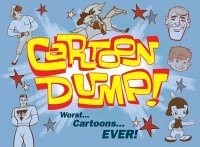 I’ve been doing that for five years at the Comic-Con. I had actually done that – well, people tell me I’ve been doing it for 20 years. I know I’d been doing it a few years before that, at other venues.
I’ve been doing that for five years at the Comic-Con. I had actually done that – well, people tell me I’ve been doing it for 20 years. I know I’d been doing it a few years before that, at other venues.
So I just recently teamed up with a partner, Frank Conniff, who was one of the regulars on Mystery Science Theater. We created a podcast, which debuted in early August. It’s called Cartoon Dump. Each podcast features one of these hilariously bad cartoons. It’s book-ended by a live-action kid show parody – a really, really down-and-out kids show, the kind that would show these bad cartoons. It’s pretty dark humored. It’s also pretty strange humored, featuring a live-action cast.
In Hollywood, where I live, we’re actually also performing this kids show as a regular monthly live event. We’re doing it the fourth Tuesday of every month. Each live show we do is completely different.
I’m excited, because I love using these bad cartoons in some new, creative, fun way. Yes, we’re hoping someone will notice us and help fund and produce more podcasts – or even take it to television. But right now, we’re doing it for fun, in Hollywood, as a live show and a limited-run podcast.
If anybody’s interested, they can go check out CartoonDump.com. Actually, I should say CartoonBrewFilms.com – that’s where we’re originating the podcast. There is also a CartoonDump.com, though, where people can find more information.
AV: I noticed on Wikipedia – and of course, we know they’re always right…
JB: Yes! They’re always right – unless I didn’t write it!
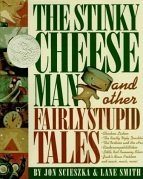 AV: [laughs] I read that at one time you were working on film adaptations for Mighty Mouse and The Stinky Cheese Man. Is that true?
AV: [laughs] I read that at one time you were working on film adaptations for Mighty Mouse and The Stinky Cheese Man. Is that true?
JB: Yes, that was about ten years ago, in 1997. For three years, I was involved with Nickelodeon as vice-president of Nickelodeon Movies. We were developing Stinky Cheese Man, Mighty Mouse and a whole bunch of other stuff.
For the Stinky Cheese Man adaptation, I met with the book’s creators. They were totally on board with creating the film. Lane Smith was going to be the director. It was going to be very cool. This was before Shrek. Stinky Cheese Man would have been the first one of these animated features to make fun of fairy tales. It would have been great, with it’s own unique style. It might have used CG, but it wouldn’t have looked like Shrek at all. It would have been a unique look that we had in mind.
There are reasons why those projects at Nickelodeon Movies didn’t happen. That’s a whole long other story. Maybe that’s another interview for another time.
You know, fifteen years ago, I was involved with distributing anime films, such as Akira, for movie theaters. It seems every couple of years, I have a new adventure in animation. Hopefully, the cumulative effect of all that stuff will pay off someday. You know, I spend half of my time creating my next job. There is no ‘Oh, they are looking for somebody to do this.’ No, I never find that. I basically have to come up with a book idea, a DVD idea, a compilation-of-comics idea. Then I go out and try to convince people to do it. I do that a lot.

is now available to own from Amazon
